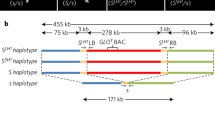Abstract
Hedyotis caerulea, a spring flowering herb widely distributed in eastern North America, has distylous flowers that differ by a number of morphological and physiological traits. The presence of a strong incompatibility system is indicated by the fact that intramorph crosses or self-pollinations produced little or no seed and intermorph crosses produced copious seed. An unusual homostyle was located that had most floral characters intermediate between pin and thrum flowers, although its pollen size was that of pin. The homostyle was only moderately self-compatible, and its pollen did not behave as pin pollen on thrum stigmas. It appears that, despite their intermediate position and morphology, the homostyle stigmas were fundamentally pin. Although the exceptional rarity of the homostyle suggests that it is an inadaptive failure, workers should watch for its further occurrence since additional study of it may provide insights into the genetic and physiological basis of heterostyly in theRubiaceae.
Similar content being viewed by others
References
Bir Bahadur, 1968: Heterostyly inRubiaceae: a review. J. Osmania Univ. (Science), Golden Jubilee Special Volume, 207–238.
Crosby, J. L., 1949: Selection of an unfavorable gene-complex. Evolution3, 212–230.
Darwin, C., 1877: The different forms of flowers on plants of the same species. London: John Murray.
Ernst, A., 1936a: Weitere Untersuchungen zur Phänanalyse, zum Fertilitätsproblem und zur Genetik heterostyler Primeln. 2.Primula hortensis Wettstein. Arch. d. J. Klaus-Stiftg.11, 1–280.
—, 1936b: Heterostylieforschung. Versuche zur genetischen Analyse eines Organisations- und „Anpassungs“-Merkmales. Zeitschr. f. ind. Abst.-u. Vererbungsl.71, 156–230.
—, 1955: Self-fertility in monomorphic Primulas. Genetica27, 391–448.
Ganders, F. R., 1975: Fecundity in distylous and self-incompatible homostylous plants ofMitchella repens (Rubiaceae). Evolution29, 186–188.
Lewis, D., 1954: Comparative incompatibility in angiosperms and fungi. Advances in Genetics6, 235–287.
Mather, K., 1950: The genetical architecture of heterostyly inPrimula sinensis. Evolution4, 340–352.
Meehan, T., 1880: Dimorphic flowers inHoustonia. Proc. Acad. Nat. Sci. Philadelphia32, 349–350.
Ornduff, R., 1970: Relationships in thePiriqueta caroliniana-P. cistoides complex (Turneraceae). J. Arnold Arb.51, 492–498.
—, 1972: The breakdown of trimorphic incompatibility inOxalis sectionCorniculatae. Evolution26, 52–65.
Ray, P. M., andChisaki, H. F., 1957: Studies onAmsinckia. I. A synopsis of the genus, with a study of heterostyly in it. Amer. J. Bot.44, 529–536.
Rothrock, J. T., 1868: The fertilization of flowering plants. Amer. Naturalist1, 64–72.
Author information
Authors and Affiliations
Rights and permissions
About this article
Cite this article
Ornduff, R. An unusual homostyle inHedyotis caerulea (Rubiaceae). Pl Syst Evol 127, 293–297 (1977). https://doi.org/10.1007/BF00985992
Received:
Issue Date:
DOI: https://doi.org/10.1007/BF00985992




